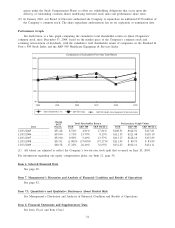Quest Diagnostics 2009 Annual Report Download - page 53
Download and view the complete annual report
Please find page 53 of the 2009 Quest Diagnostics annual report below. You can navigate through the pages in the report by either clicking on the pages listed below, or by using the keyword search tool below to find specific information within the annual report.Healthcare insurers, which typically negotiate directly or indirectly on behalf of their members, represent
approximately one-half of our clinical testing volumes and one-half of our net revenues from our clinical testing
business. Larger healthcare insurers typically prefer to use large commercial clinical laboratories because they can
provide services to their members on a national or regional basis. In addition, larger commercial clinical
laboratories are better able to achieve the low-cost structures necessary to profitably service the members of large
healthcare insurers and can provide test utilization data across various products in a consistent format. In certain
markets, such as California, healthcare insurers may delegate their covered members to independent physician
associations, which in turn negotiate with laboratories for clinical testing services on behalf of their members.
The trend of consolidation among physicians, hospitals, employers, healthcare insurers, pharmaceutical
companies and other intermediaries has continued, resulting in fewer but larger customers and payers with
significant bargaining power to negotiate fee arrangements with healthcare providers, including clinical
laboratories. Healthcare insurers often require that clinical testing service providers accept discounted fee
structures or assume all or a portion of the utilization risk associated with providing testing services to their
members enrolled in highly-restricted plans through capitated payment arrangements. Under these capitated
payment arrangements, we and the healthcare insurers agree to a predetermined monthly reimbursement rate for
each member enrolled in the healthcare plan’s restricted plan, generally regardless of the number or cost of
services provided by us. Our cost to perform testing services reimbursed under capitated payment arrangements is
not materially different from our cost to perform testing services reimbursed under other arrangements with
healthcare insurers. Since average reimbursement rates under capitated payment arrangements are typically less
than our overall average reimbursement rate, the testing services reimbursed under capitated payment
arrangements are generally less profitable. In 2009, we derived approximately 14% of our testing volume and 5%
of our clinical testing net revenues from capitated payment arrangements.
Most healthcare insurers also offer programs such as preferred provider organizations (“PPOs”) and
consumer driven health plans that offer a greater choice of healthcare providers. Pricing for these programs is
typically negotiated on a fee-for-service basis, which generally results in higher revenue per requisition than
under capitation arrangements. Most of our agreements with major healthcare insurers are non-exclusive
arrangements. As a result, under these non-exclusive arrangements, physicians and patients have more freedom of
choice in selecting laboratories, and laboratories are likely to compete more on the basis of service and quality
than they may otherwise. It is increasingly important for healthcare providers to differentiate themselves based on
quality, service and convenience to avoid competing on price alone.
Despite the general trend of increased choice for patients in selecting a healthcare provider, recent
experience indicates that some healthcare insurers may actively seek to limit the choice of patients and physicians
if they feel it will give them increased leverage to negotiate lower fees, by consolidating services with a single
or limited network of contracted providers. Historically, healthcare insurers, which had limited their network of
laboratory service providers, encouraged their members, and sometimes offered incentives, to utilize only
contracted providers. Patients who use a non-contracted provider may have a higher co-insurance responsibility,
which may result in physicians referring testing to contracted providers to minimize the expense to their patients.
In cases where members choose to use a non-contracted provider due to service, quality or convenience, the non-
contracted provider would be reimbursed at rates considered “reasonable and customary.” Contracted rates are
generally lower than “reasonable and customary” rates.
We also may be a member of a “complementary network.” A complementary network is generally a set of
contractual arrangements that a third party will maintain with various providers which provide discounted fees for
the benefit of its customers. A member of a health plan may choose to access a non-contracted provider that is a
member of a complementary network; if so, the provider will be reimbursed at a rate negotiated by the
complementary network.
We expect that reimbursements for the diagnostic testing industry will continue to remain under pressure.
Today, the federal and many state governments face serious budget deficits and healthcare spending is subject to
reductions, and efforts to reduce reimbursements and stringent cost controls by government and other payers for
existing tests may continue. However, we believe that as new tests are developed which either improve on the
effectiveness of existing tests or provide new diagnostic capabilities, the government and other payers will add
these tests as covered services, because of the importance of laboratory testing in assessing and managing the
health of patients. We continue to emphasize the importance and the high value of laboratory testing with
healthcare insurers and government payers at the federal and state level.
43
























